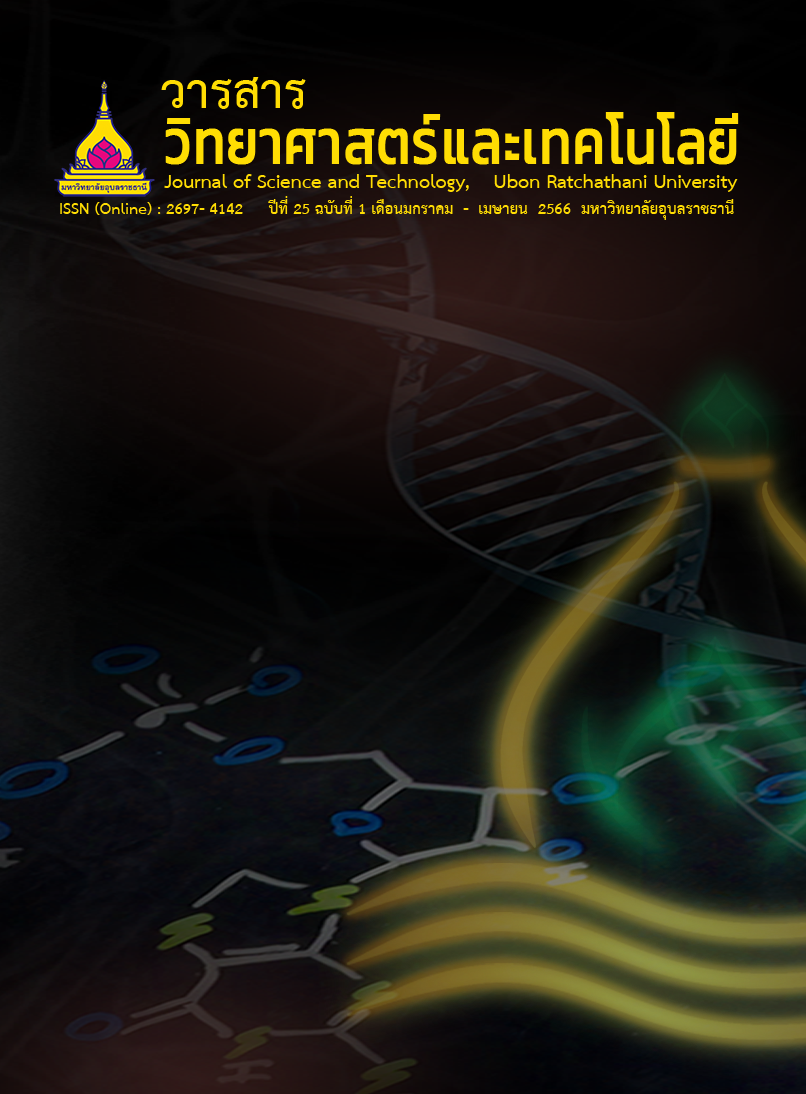ฤทธิ์ทำลายแบคทีเรียและกลไกการยับยั้งของกรดโคจิกต่อ Pseudomonas aeruginosa
Main Article Content
บทคัดย่อ
กรดโคจิกนิยมใช้ในผลิตภัณฑ์เครื่องสำอางเพื่อเพิ่มความขาวให้แก่ผิว การปนเปื้อนจุลินทรีย์เป็นหนึ่งในปัญหาที่สำคัญที่พบในเครื่องสำอาง เนื่องจากเครื่องสำอางมีส่วนประกอบหลายชนิดที่เอื้อต่อการเจริญของจุลินทรีย์ Pseudomonas aeruginosa เป็นแบคทีเรียที่ไม่เพียงแค่พบบ่อยว่ามีการปนเปื้อนในเครื่องสำอางเท่านั้น แต่ยังก่อโรคติดเชื้อที่ผิวหนังได้อีกด้วย การศึกษานี้มีวัตถุประสงค์เพื่อประเมินประสิทธิภาพและกลไกของกรดโคจิกในการยับยั้งการเจริญของ P. aeruginosa จากการทดสอบด้วยวิธี swab paper disc พบว่ากรดโคจิกสามารถยับยั้งการเจริญของ P. aeruginosa วิธี broth dilution แสดงให้เห็นว่าความเข้มข้นที่น้อยที่สุด (MIC) ของกรดโคจิกในการยับยั้งการเจริญของ P. aeruginosa เท่ากับร้อยละ 1 กรดโคจิกที่ความเข้มข้นเท่ากับ MIC มีกลไกการยับยั้ง P. aeruginosa แบบทำให้เซลล์ตาย โดยทำให้เซลล์ผิดรูปจากการศึกษาด้วยกล้องจุลทรรศน์อิเล็กตรอนแบบส่องกราด และทำให้เกิดการรั่วไหลของกรดนิวคลีอิกและโปรตีนออกจากเซลล์ P. aeruginosa เมื่อศึกษาด้วยวิธีสเปกโทรโฟโตเมตรีที่ความยาวคลื่น 260 และ 280 นาโนเมตร ตามลำดับ ผลการทดลองนี้อาจเป็นประโยชน์สำหรับเป็นแนวทางในการพิจารณาปริมาณกรดโคจิกที่เหมาะสมที่จะใช้ในเครื่องสำอางเพื่อยับยั้งแบคทีเรีย
Article Details

อนุญาตภายใต้เงื่อนไข Creative Commons Attribution-NonCommercial-NoDerivatives 4.0 International License.
บทความที่ได้รับการตีพิมพ์เป็นลิขสิทธิ์ของ วารสารวิทยาศาสตร์และเทคโนโลยี มหาวิทยาลัยอุบลราชธานี
ข้อความที่ปรากฏในบทความแต่ละเรื่องในวารสารวิชาการเล่มนี้เป็นความคิดเห็นส่วนตัวของผู้เขียนแต่ละท่านไม่เกี่ยวข้องกับมหาวิทยาลัยอุบลราชธานี และคณาจารย์ท่านอื่นๆในมหาวิทยาลัยฯ แต่อย่างใด ความรับผิดชอบองค์ประกอบทั้งหมดของบทความแต่ละเรื่องเป็นของผู้เขียนแต่ละท่าน หากมีความผิดพลาดใดๆ ผู้เขียนแต่ละท่านจะรับผิดชอบบทความของตนเองแต่ผู้เดียว
เอกสารอ้างอิง
Rattanachaikunsopon, P. and Phumkhachorn, P. 2021. Kojic acid: its properties and applications. Journal of Science and Technology Mahasarakham University. 40(3): 235-243. (in Thai)
Brtko, J. 2022. Biological functions of kojic acid and its derivatives in medicine, cosmetics, and food industry: Insights into health aspects. Archiv der Pharmazie. 355(10): e2200215.
Zhao, X. and et al. 2019. Storage and preservative study of tropical fruits by kojic acid. IOSR Journal of Agriculture and Veterinary Science. 12(11): 84-90.
Singh, B.K. and et al. 2016. Kojic acid peptide: A new compound with anti-tyrosinase potential. Annals of Dermatology. 28(5): 555-561.
Saeedi, M., Eslamifar, M. and Khezri, K. 2019. Kojic acid applications in cosmetic and pharmaceutical preparations. Biomedicine and Pharmacotherapy. 110: 582-593.
Sanjotha, G., Shivasharana, C.T. and Manawadi, S.T. 2019. An in vitro approach for evaluating antimicrobial activity and production of kojic acid by Aspergillus flavus isolated from Karwar region. Journal of Pure and Applied Microbiology. 13(4): 2261-2272.
Zilles, J.C. and et al. 2022. Biological activities and safety data of kojic acid and its derivatives: A review. Experimental Dermatology. 31(10): 1500-1521.
Karakaya, G. and et al. 2019. Kojic acid derivatives as potential anticancer agents: synthesis and cytotoxic evaluation on A375 human malignant melanoma cells. Journal of Research in Pharmacy. 23(4): 596-607.
Kim, H.W. and et al. 2020. Risk factors influencing contamination of customized cosmetics made on-the-spot: Evidence from the national pilot project for public health. Scientific Reports. 10: 1561.
Neza, E. and Centini, M. 2016. Microbiologically contaminated and over-preserved cosmetic products according Rapex 2008-2014. Cosmetics. 3(1): 3.
Dadashi, L. and Dehghanzadeh, R. 2016. Investigating incidence of bacterial and fungal contamination in shared cosmetic kits available in the women beauty salons. Health Promotion Perspectives. 6(3): 159-163.
Qin, S. and et al. 2022. Pseudomonas aeruginosa: pathogenesis, virulence factors, antibiotic resistance, interaction with host, technology advances and emerging therapeutics. Signal Transduction and Targeted Therapy. 7: 199.
Srisutham, W. and et al. 2018. Influence of temperature on antimicrobial activity and mode of action of thymol against Escherichia coli O157:H7. Journal of Science and Technology, Ubon Ratchathani University. 20(1): 36-43. (in Thai)
Wu, Y. and et al. 2018. Evaluation of antibacterial and anti-biofilm properties of kojic acid against five food-related bacteria and related subcellular mechanisms of bacterial inactivation. Food Science and Technology International. 25(1): 3-15.
Liu, X. and et al. 2014. Synthesis, characterization, and antimicrobial activity of kojic acid grafted chitosan oligosaccharide. Journal of Agricultural and Food Chemistry. 62: 297-303.
Saaaquib, S.A. and et al. 2019. Evaluation and comparison of antibacterial efficacy of herbal extracts in combination with antibiotics on periodontal pathobionts: An in vitro microbiological study. Antibiotics. 8(89): 1-12.
Phasha, V. and et al. 2022. Review on the use of kojic acid-A skin-lightening ingredient. Cosmetics. 9(3): 64.
Mogana, R. and et al. 2020. Antibacterial activities of the extracts, fractions and isolated compounds from Canarium patentinervium Miq. against bacterial clinical isolates. BMC Complementary Medicine and Therapies. 20(55): 1-11.
Wijesundara, N.M. and et al. 2022. Bactericidal activity of carvacrol against Streptococcus pyogenes involves alteration of membrane fluidity and integrity through interaction with membrane phospholipids. Pharmaceutics. 14(10): 1992.


